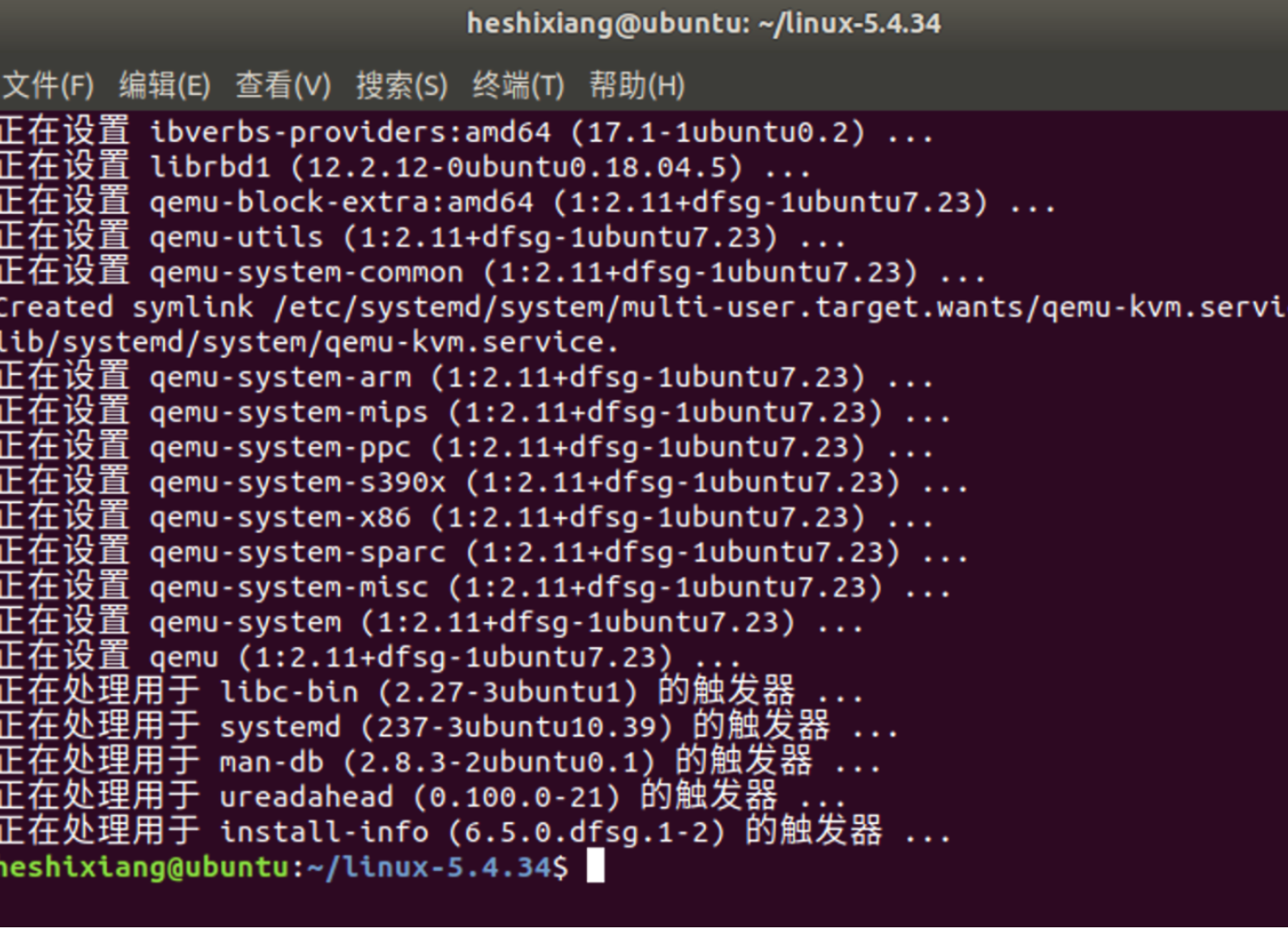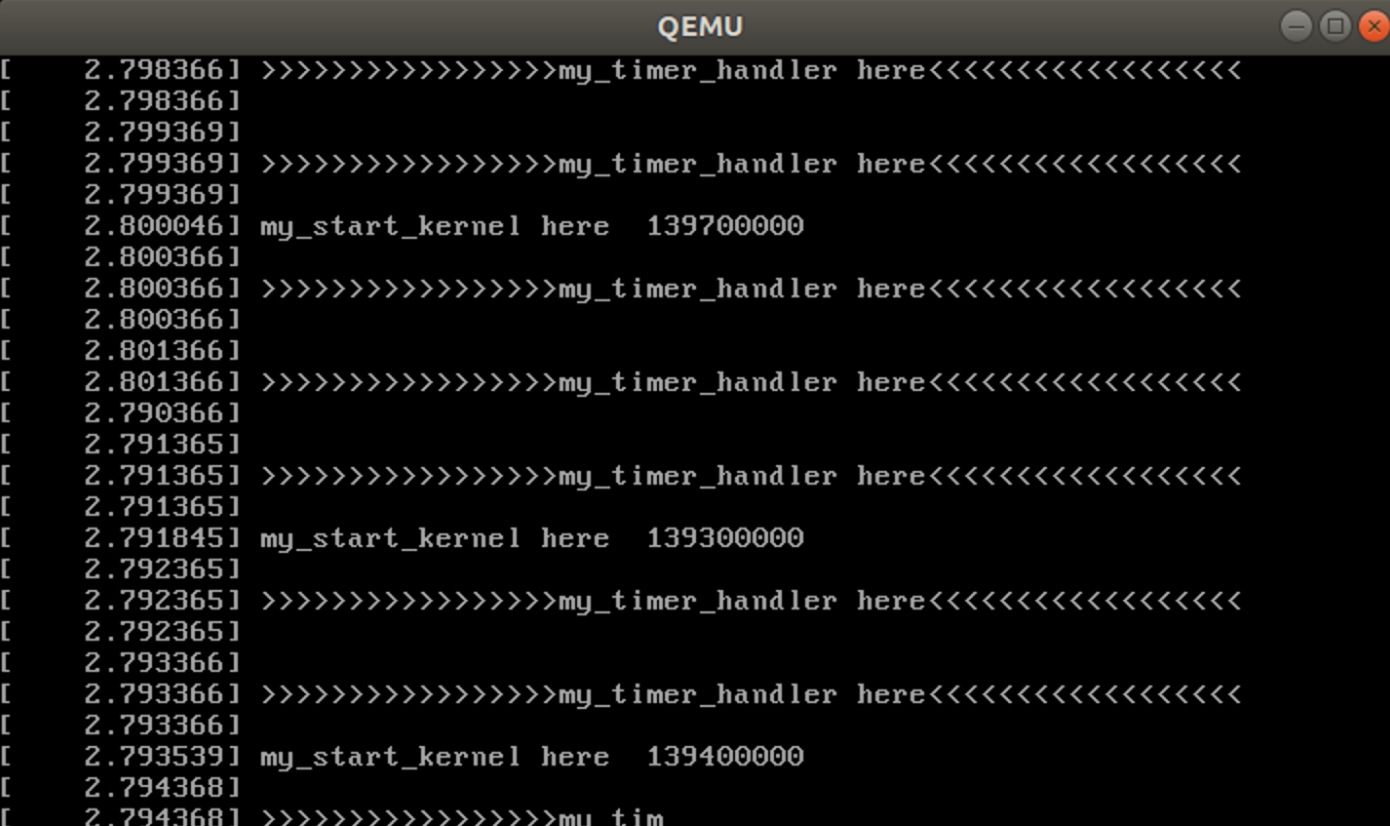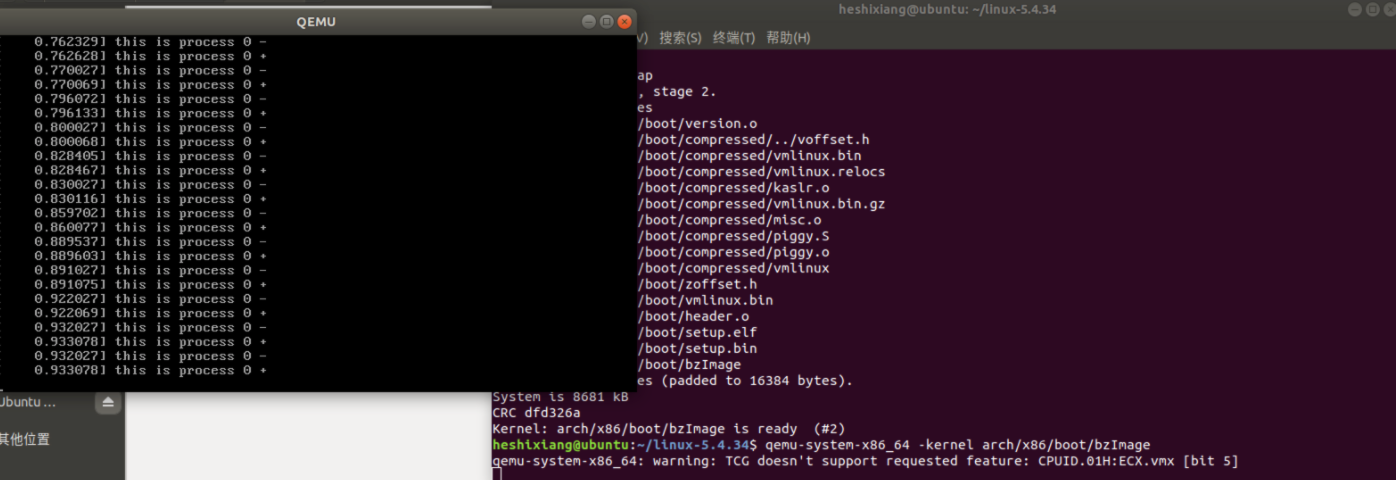基于mykernel2.0编写一个操作系统内核
一. 实验准备
- 详细要求
基于mykernel 2.0编写一个操作系统内核
- 按照https://github.com/mengning/mykernel 的说明配置mykernel 2.0,熟悉Linux内核的编译;
- 基于mykernel 2.0编写一个操作系统内核,参照https://github.com/mengning/mykernel 提供的范例代码
- 简要分析操作系统内核核心功能及运行工作机制
- 实验环境
发行版本:Ubuntu 18.04.4 LTS
处理器:Intel® Core™ i7-8850H CPU @ 2.60GHz × 3
图形卡:Parallels using AMD® Radeon pro 560x opengl engine
GNOME:3.28.2
二. 实验过程
- Set up mykernel 2.0
依次执行如下的指令
wget https://raw.github.com/mengning/mykernel/master/mykernel-2.0_for_linux-5.4.34.patch
sudo apt install axel
axel -n 20 https://mirrors.edge.kernel.org/pub/linux/kernel/v5.x/linux-5.4.34.tar.xz
xz -d linux-5.4.34.tar.xz
tar -xvf linux-5.4.34.tar
cd linux-5.4.34
patch -p1 < ../mykernel-2.0_for_linux-5.4.34.patch
sudo apt install build-essential libncurses-dev bison flex libssl-dev libelf-dev
make defconfig
make -j$(nproc)
sudo apt install qemu
qemu-system-x86_64 -kernel arch/x86/boot/bzImage

执行成功并运行后可以看到如下的界面

- qemu窗口中输出的内容来自代码mymain.c和myinterrupt.c。先查看一下代码内容
mymain.c
#ifdef CONFIG_X86_LOCAL_APIC
#include <asm/smp.h>
#endif
void __init my_start_kernel(void)
{
int i = 0;
while(1)
{
i++;
if(i%100000 == 0)
pr_notice("my_start_kernel here %d
",i);
}
}
nyinterrupt.c
/*
* Called by timer interrupt.
*/
void my_timer_handler(void)
{
pr_notice("
>>>>>>>>>>>>>>>>>my_timer_handler here<<<<<<<<<<<<<<<<<<
");
}
- 首先在mykernel目录下增加一个mypcb.h 头文件,用来定义进程控制块(Process Control Block),也就是进程结构体的定义,在Linux内核中是struct tast_struct结构体
/*
* linux/mykernel/mypcb.h
*/
#define MAX_TASK_NUM 4
#define KERNEL_STACK_SIZE 1024*8
/* CPU-specific state of this task */
struct Thread {
unsigned long ip;
unsigned long sp;
};
typedef struct PCB{
int pid;
volatile long state; /* -1 unrunnable, 0 runnable, >0 stopped */
char stack[KERNEL_STACK_SIZE];
/* CPU-specific state of this task */
struct Thread thread;
unsigned long task_entry;
struct PCB *next;
}tPCB;
void my_schedule(void);
- 修改mymain.c中的my_start_kernel函数,并在mymain.c中实现了my_process函数,用来作为进程的代码模拟一个个进程,时间片轮转调度。
#include "mypcb.h"
tPCB task[MAX_TASK_NUM];
tPCB * my_current_task = NULL;
volatile int my_need_sched = 0;
void my_process(void);
void __init my_start_kernel(void)
{
int pid = 0;
int i;
/* Initialize process 0*/
task[pid].pid = pid;
task[pid].state = 0;/* -1 unrunnable, 0 runnable, >0 stopped */
task[pid].task_entry = task[pid].thread.ip = (unsigned long)my_process;
task[pid].thread.sp = (unsigned long)&task[pid].stack[KERNEL_STACK_SIZE-1];
task[pid].next = &task[pid];
/*fork more process */
for(i=1;i<MAX_TASK_NUM;i++)
{
memcpy(&task[i],&task[0],sizeof(tPCB));
task[i].pid = i;
task[i].state = -1;
task[i].thread.sp = (unsigned long)&task[i].stack[KERNEL_STACK_SIZE-1];
task[i].next = task[i-1].next;
task[i-1].next = &task[i];
}
/* start process 0 by task[0] */
pid = 0;
my_current_task = &task[pid];
asm volatile(
"movq %1,%%rsp
" /* set task[pid].thread.sp to rsp */
"pushq %1
" /* push rbp */
"pushq %0
" /* push task[pid].thread.ip */
"ret
" /* pop task[pid].thread.ip to rip */
:
: "c" (task[pid].thread.ip),"d" (task[pid].thread.sp) /* input c or d mean %ecx/%edx*/
);
}
void my_process(void)
{
int i = 0;
while(1)
{
i++;
if(i%10000000 == 0)
{
printk(KERN_NOTICE "this is process %d -
",my_current_task->pid);
if(my_need_sched == 1)
{
my_need_sched = 0;
my_schedule();
}
printk(KERN_NOTICE "this is process %d +
",my_current_task->pid);
}
}
}
- 对myinterrupt.c进行修改,my_timer_handler用来记录时间片,时间片消耗完之后完成调度。
#include "mypcb.h"
extern tPCB task[MAX_TASK_NUM];
extern tPCB * my_current_task;
extern volatile int my_need_sched;
volatile int time_count = 0;
/*
* Called by timer interrupt.
*/
void my_timer_handler(void)
{
if(time_count%1000 == 0 && my_need_sched != 1)
{
printk(KERN_NOTICE ">>>my_timer_handler here<<<
");
my_need_sched = 1;
}
time_count ++ ;
return;
}
void my_schedule(void)
{
tPCB * next;
tPCB * prev;
if(my_current_task == NULL
|| my_current_task->next == NULL)
{
return;
}
printk(KERN_NOTICE ">>>my_schedule<<<
");
/* schedule */
next = my_current_task->next;
prev = my_current_task;
if(next->state == 0)/* -1 unrunnable, 0 runnable, >0 stopped */
{
my_current_task = next;
printk(KERN_NOTICE ">>>switch %d to %d<<<
",prev->pid,next->pid);
/* switch to next process */
asm volatile(
"pushq %%rbp
" /* save rbp of prev */
"movq %%rsp,%0
" /* save rsp of prev */
"movq %2,%%rsp
" /* restore rsp of next */
"movq $1f,%1
" /* save rip of prev */
"pushq %3
"
"ret
" /* restore rip of next */
"1: " /* next process start here */
"popq %%rbp
"
: "=m" (prev->thread.sp),"=m" (prev->thread.ip)
: "m" (next->thread.sp),"m" (next->thread.ip)
);
}
return;
}
- 更改后的运行结果:

进程切换过程中进程0和进程1的堆栈和相关寄存器的变化过程大致如下:
- pushq %%rbp 保存prev进程(本例中指进程0)当前RBP寄存器的值到prev进程的堆栈;
- movq %%rsp,%0 保存prev进程(本例中指进程0)当前RSP寄存器的值到prev->thread.sp,这时RSP寄存器指向进程的栈顶地址,实际上就是将prev进程的栈顶地址保存;%0、%1...指这段汇编代码下面输入输出部分的编号。
- movq %2,%%rsp 将next进程的栈顶地址next->thread.sp放入RSP寄存器,完成了进程0和进程1的堆栈切换。
- movq $1f,%1 保存prev进程当前RIP寄存器值到prev->thread.ip,这里$1f是指标号1。
- pushq %3 把即将执行的next进程的指令地址next->thread.ip入栈。
- ret 就是将压入栈中的next->thread.ip放入rip寄存器,rip寄存器现在存储next进程的指令。
- 1: 标号1是一个特殊的地址位置,该位置的地址是$1f。
- popq %%rbp 将next进程堆栈基地址从堆栈中恢复到RBP寄存器中。
三. 总结
这次实验主要做了如下的事情:
- 学习并完成实验环境的配置的搭建
- 学习并了解Linux内核编译相关知识
- 通过实践加深对编译的学习与体会
- 基于mykernel 2.0编写一个操作系统内核
- 思考代码执行的各项原理